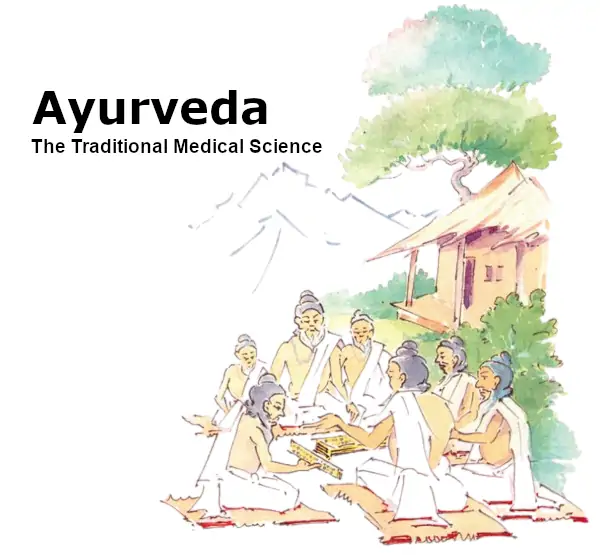Ayurveda: The Ancient Science of Life
The Sanskrit word, आयुर्वेद – Ayurveda related to the holy book वेद – Veda, means the science of life, and life is the state of being alive which rejects suffering to survive with the aim of happiness. Suffering and happiness are contradictory subjects of the mind; the cause of them is the body because the mind can not be active without the function of the bodily organs. Mind, by nature, rejects suffering because the destination of life is happiness. But suffering is a truth of a sentient being, life does not exist without suffering. In this sense, the entire function of the mind concentrates on leading the body to avoid suffering for happiness.
The Union of Body and Mind in Ayurvedic Thought
The body and the mind are the physical and metaphysical units of life. The functions of these two units with mutual co-ordination clear the real significance of life. The body of a living being as a physical cause of suffering can mislead the mind and the mind, at the moment, can not function properly. In general, the body has to be led by the mind to have the proper function of the bodily organs. But, in certain conditions of delusion, greed, grief, fear, lust, etc, the mind fails to control the body and that causes suffering. The word, suffering, in the medical aspect, is considered as a word of sickness which indicates something wrong in the constitution of the mind and the body.
Ayurveda’s Approach to Balance and Health
The constructive and destructive functions of the body are the two major life factors. Happiness as a result of a balanced life is related to constructive factors that encourage the mind to lead the body to its proper function. And, the suffering as a result of an imbalanced life is related to a destructive factor that awakens the mind to be alert to restore the balance of the bodily constitution. In this sense, the balanced life, in fact, is the significance of health and the imbalanced life is considered as a fundamental cause of sickness. The knowledge gained from generation to generation of mankind for the maintenance of the balance of these two factors is the main subject of Ayurveda. Therefore Ayurveda, as a science of life deals with good life and bad life as well as happy life and unhappy life. And, what is good and bad for life that all understandings are the fundamental subjects of Ayurvedic texts.
The Eight Branches of Ayurveda: A Comprehensive System
The practical fields of Ayurveda dealing with all physical and meta physical diseases, are divided into eight sections or branches. These sections are known by the names of 1) Kayachikitsa Tantra (the section of internal medicine), 2) Shalya Tantra (the section of surgery), 3) Shalakya Tantra (the section of cranial organo medicine), 4) Kaumarabhritya Tantra (the section of pediatrics), 5) Agada Tantra (the section of toxicology), 6) Rasayana Tantra (the section of rejuvenating remedy), 7) Vajikaran Tantra (the section of aphrodisiac remedy) and 8) Bhuta Vidya (the section of spiritual healing). These eight sections or branches of Ayurveda are called “Astanga Ayurveda” which has different schools and traditions run by different scholars known in ancient times as Rishis and Munis. The renowned Rishis and Munis who are connected with Ayurveda and its basic sciences, lived in Aryavarta, the land of the surrounding area of the Himalayas. In the field of complete and comprehensive medical science, the potential contribution of Rishis and Munis is still beneficial to maintaining the health of mankind. Especially in the field of basic sciences related to Ayurveda, their contribution is very important, because, without a profound understanding of basic sciences, Ayurveda can not be an authorized science.








Ayurveda’s Foundational Sciences
The main basic science related to Ayurveda includes philosophy, the principle of pathogenic agents, the theory of diagnosis; the theory of treatment; anatomy and physiology; the study of lifespan; physics; pharmacology; botany; zoology; alchemy; hygiene; dietetics; psychology; five cleaning methods and pharmaceutics. To be a Vaidya, an Ayurvedic physician, the study of Ayurveda with the eight branches of Ayurveda and the basic sciences related to Ayurveda is very essential.
Ayurveda’s Enduring Legacy in the Himalayan Region
The traditional medical system of the Himalayan countries; Nepal, India etc is based on the principle of Ayurveda. It is still running from generation to generation in the family of Vaidyas. They pass down their knowledge recorded in the texts. The Ayurvedic texts are written in Sanskrit, the ancient formal languages of Rishis and Munis. Some important manuscripts are published in different languages and some manuscripts which are not published still are available in the collection of traditional physicians.
Conclusion
Time has passed in the wave of history, and the glory of Ayurveda, no doubt, is badly affected by natural and human disasters. The intellectual schools run by the renowned Rishis and Munis remained only in the domestic families of Vaidyas. Many valuable manuscripts mentioned in the different Ayurvedic schools have disappeared. Divine plants used for long life and good health are eradicated. Many renowned families of specialized Vaidyas could not stand to run their traditions. Besides these all negative conditions, the positive value of Ayurveda is not affected as yet, because, the principle of Ayurveda is based on the universal truth. And Ayurveda is an intellectual gift of ancient human civilization to mankind.
Author
Dr. Mana Bajra Bajracharya
PIYUSHABARSHI AUSHADHALAYA
Ayurvedic Clinic
Mahabouddha, Kathmandu, Nepal
For any inquiries or questions, please contact us
Copyright © AyurvedicClinic.Net. All rights reserved. Republishing and copying without authorization is prohibited.

